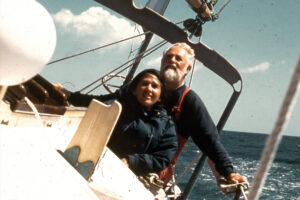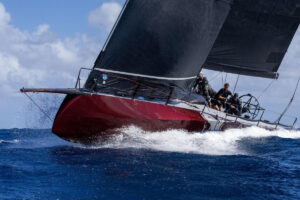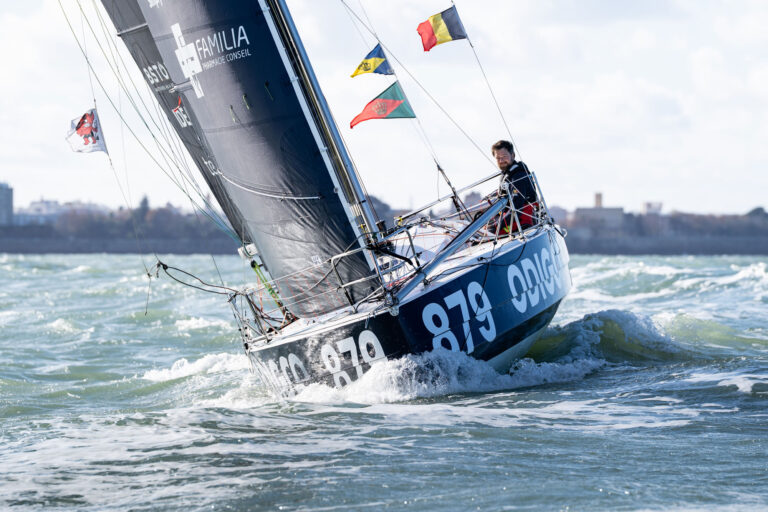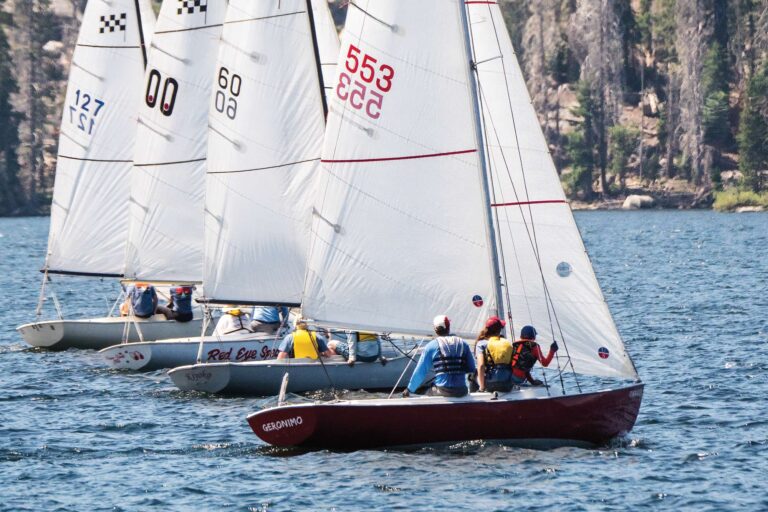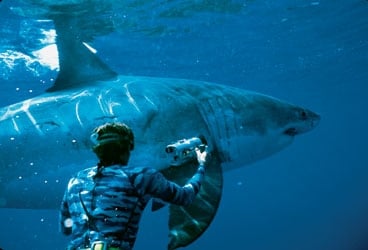
AprFeatHallSt
For some inexplicable reason, whenever something interesting swims into the chunk of water through which I’m sailing, my first response is to jump in and see the beast in its own element. Sometimes, depending on the size or rarity of the approaching creature or creatures, this urge to abandon ship is so overwhelming that the fates of both the vessel and the abandoner-meaning me-become secondary.
I’m not alone in this desire, a fact proven by the time two old friends and I frolicked with hundreds of dolphins in the middle of Kaua’i Channel, in Hawai’i. Caught up in the excitement, everyone seemed to think that leaving my 30-foot Ericson sloop, Hoku Pa’a, completely unmanned-with the main set, engine idling, and 30 miles from land-really wasn’t a bad idea. With no wind, the sail was set just to slow the roll, so the risk that an errant gust would take our vessel for a ghost ride was, considering the unforgettable rewards, worth taking. Of course, being left treading water in the middle of nowhere would’ve also been rather tough to forget.
So far, no matter the species, I haven’t been able to resist leaping in for a closer look. This has rewarded me with up close and personal encounters with whales, tiger sharks, oceanic sunfish, dugongs, enormous groupers, whale sharks, manta rays, and killer whales. I used to call killer whales by their more official name-orcas-but since having confronted a pair of them eyeball-to-eyeball from some 20 feet, I find it a much better story if I call them killer whales.
On occasion, this overwhelming urge to get in the water has been met tenfold by a desire to get the hell out. The most obvious case in point was the time a friend and I were caught in the middle of a shark feed gone awry off the Cook Islands, in the South Pacific. That was the only time I’ve ever lost all control and completely panicked. In the blink of an eye, what had been 10 or so mildly agitated sharks turned into 10 or so extremely agitated sharks. Engulfed in the middle of an underwater maelstrom of frenzied sharks, fish carcasses, chum, and turbulent water, two slightly foolish-some would say entirely brainless-divers wanted nothing more than to get out of the water. As sharks crashed against us from all sides, we freaked out and bolted for the dinghy. Yes, another unforgettable experience. Was it worth the risk? Maybe not that time.
Divers spend thousands and thousands of dollars to travel all over the world in hopes of encounters with big sea creatures. If you spend enough money, travel far enough at the right time of year, and the weather, tides, boats, and equipment cooperate, your chances of seeing something big are quite good. You can go to the reefs off Ningaloo, in Western Australia, where a spotter plane will direct you all day long to whale sharks. Or you could visit the South Atlantic Ocean off Cape Town, South Africa, and practically kiss a great white shark on the nose. Better yet, spend a couple of weeks on a liveaboard dive boat off Isla del Coco, southwest of Costa Rica, and rub fins with just about everything that swims in the sea. But no matter how much you spend or how great a place you go, just cruising on your boat is likely to be better. Here’s why: To see cool things, you have to spend a lot of time on the water. And what is it that cruisers do? Exactly.
By keeping an eye somewhat peeled, having some basic dive gear at hand, and being ready to hit the water at a moment’s notice, any cruising sailor on any given day could experience the kind of underwater encounter that would leave most divers with quite a tale to tell. This won’t happen every day-in fact it won’t even happen very often-but when it does, it’ll be something you’ll never forget and something you can’t wait to do again. Of course, that’s assuming you live through it.
The biggest thrill of mixing diving and cruising is just how special the random encounters can be. Cruisers who are into diving do their route planning with known attractions in mind. I’ve done this, and it’s rewarded me with many delightful dives, including one on the gigantic shipwreck of the SS President Coolidge, off Espiritu Santo, Vanuatu’s largest island, and several others exploring Mil Entrance, off Yap, in the Federated States of Micronesia, which is full of manta rays; Palau’s Blue Corner, also in the F.S.M.; and Bali, in Indonesia, where I spotted many oceanic sunfish. Sensational diving is practically a given at these places, and my planning paid off: I wasn’t disappointed.
However, as good as these dives were, they can’t compare to the ones I’ve found on my own. There’s something extra-special about just stumbling across something unexpected, something just as spectacular as anything advertised in any dive magazine or featured on the Discovery Channel.
My absolute favorite encounter was made so by the pure randomness of it. My frequent diving partner, my mom, Linda Tatreau-yes, we’re an unlikely but very fun adventure team-and I had been cruising through Vanuatu for several weeks and were in the Maskelynes Islands, just south of the island of Malakula. As usual, we were in the inflatable dinghy and searching for a promising dive site. A vague bit of inside information had us thinking we might come across “a big, black, sleeping fish,” but for the most part we were on our own, enjoying a beautiful day in a beautiful place and taking what came our way.
With the bow pointed south and Mom looking north, an excited declaration suddenly came from Mom: “Something really big is jumping behind us!” Naturally, we turned around to investigate.
By the time we reached the site of the splashing, what we assumed were whales had sounded. We killed the engine and drifted. Our wait ended abruptly when the last thing we’d expected to see, a top-of-the-food-chain, larger-than-life, Free Willy-style killer whale cleared the water in a spectacular breach less than 100 feet from our tiny dinghy. Other whales followed, and we found ourselves in the center of the pod. Our little rubber boat, with us in it, had become the orcas’ center of attention. So we jumped in for a better look.
As soon as the bubbles cleared, I found myself face-to-face with a pair of animals that possessed the ability to consume me with a small number of bites. I hoped they didn’t feel so inclined, but I wasn’t really at all worried. My primary concern was getting some photos, at which I failed miserably. As I fumbled with my camera, the two orcas swam below me, then turned around and struck a very photogenic pose. I had a convulsive fit, and they swam away.
Back in the dinghy, both Mom and I were shaking with excitement and dying for another look. The orcas, curiosity satisfied, were again on the move and not very cooperative. We chased them for nearly an hour as they sped toward the open ocean. They didn’t seem to mind our revved-up, barely keeping up dinghy, but every time we jumped in the water, they just sped by us, and all we saw were blurred shades of black and white off in the distant blue. During our pursuit, the whales continued breaching, always leaping high and often very close to us, but that wasn’t the view we wanted, nor the one that we’d remember.
To me, cruising is a means to find awesome adventures in remote places that are accessible by almost no other means than on board your own boat. You alone are 100-percent responsible for the adventure, and the feeling when you make it happen is one of great satisfaction. Add cruising to diving, and both just get better. There’s no better sport to take cruising with you than diving, and there may be no better way to go diving than by cruising. Seeing a killer whale or any other wild animal at Sea World or at a zoo is stunning. Seeing that same animal in the wild is infinitely more breathtaking. And to see that same creature unexpectedly and at close range on your own personal adventure is absolutely beyond compare. As for swimming with killer whales, that may not be for everyone-but the thrill of swimming in close proximity to any of Mother Nature’s other masterpieces most definitely is.
Kodak Moments
When it comes to equipment, technology is on your side. The instant gratification of digital images makes photography more fun because you immediately know what you’re getting. The downside is that even though you can now get a five-megapixel camera for a couple of hundred bucks, you’re going to have to spend some money to get good shots underwater.
When it comes to shooting photos or video underwater, the most important rule is that you must be close. When compared to air, even the clearest water is practically opaque. To get a good shot of a shark, you can’t zoom in like you would on a lion in the Serengeti-you have to get close. When choosing equipment, how wide your lens or port opens should be one of your primary concerns. Even though many cameras and camcorders have a zoom function, even at their widest setting, your field of view when fully zoomed out is still too narrow, and it’ll take additional means to widen it.
With video cameras, the port on the housing generally dictates the field of view. With still cameras that have interchangeable lenses, it’s a combination of the camera lens and the housing port that determines your field of view. On still cameras without interchangeable lenses, the only way to widen the field of view is with an adapter that threads onto the housing. This tends to be the most economical route, but it’s a solution that’s less desirable in terms of quality. Zoom lenses work on both video and still cameras, but zooming in tight on a distant subject rarely yields good results.
When picking a camera, remember that you’ll also need to buy a housing for it. If you choose a popular model from a popular brand, you’ll have a bigger selection of housings from which to choose. Be sure to research both cameras and housings before making a purchase.
The most popular brands of video cameras are Sony and Canon, and the most popular brands of still cameras are Nikon and Canon. Good digital-video cameras from Sony or Canon will shoot mini-DV tapes, and they start at about a $1,000. High-definition video is becoming very popular and affordable. For still cameras, expect to pay $700 and up. Don’t get caught up with the number of pixels, as any single-lens reflex camera in that range will have plenty. Be more concerned with features and the availability of housings.
For underwater video, I shoot with Sony camcorders and Gates housings. The Gates housings aren’t cheap, but they’re very durable, and the quality is exceptional. For still photos, I use Nikon cameras and Aquatica housings. I’ve found the Aquatica housings to be a great bang for the buck. You can spend a lot more, but I’m not sure it’s necessary.
There’s a vast amount of equipment out there, and if you’re just getting started in underwater photography, these tips should merely be the beginning of your research. There are plenty of websites on the Internet dedicated to underwater photo and video, and a great place to start is Backscatter Underwater Video and Photo (www.
backscatter.com). Good photo and video equipment can get very expensive, and taking it underwater makes it even more so. But even if you can’t afford the good stuff, any camera is better that no camera, and average pictures are better than none.
Dive Gear
Here’s the good news: A good-fitting mask, snorkel, and fins are usually all the gear you’ll need. For spontaneous encounters, most of the other stuff just wastes time and gets in the way. If the water’s cold, a wetsuit’s nice, but it also slows you down. For deeper or less spur-of-the-moment dives, scuba gear may be the way to go, and if it doesn’t frighten the subjects of your photos, not having to come up for air will make shooting much easier.
Company Contacts
Aquatica: (514) 737-9481, www.aquatica.ca
Canon: (800) 385-2155, www.canonestore.com
Gates: (858) 875-1052, www.gateshousings.com
Nikon: (800) 645-6687, www.nikonusa.com
Sony: (877) 865-7669, www.sony.com

